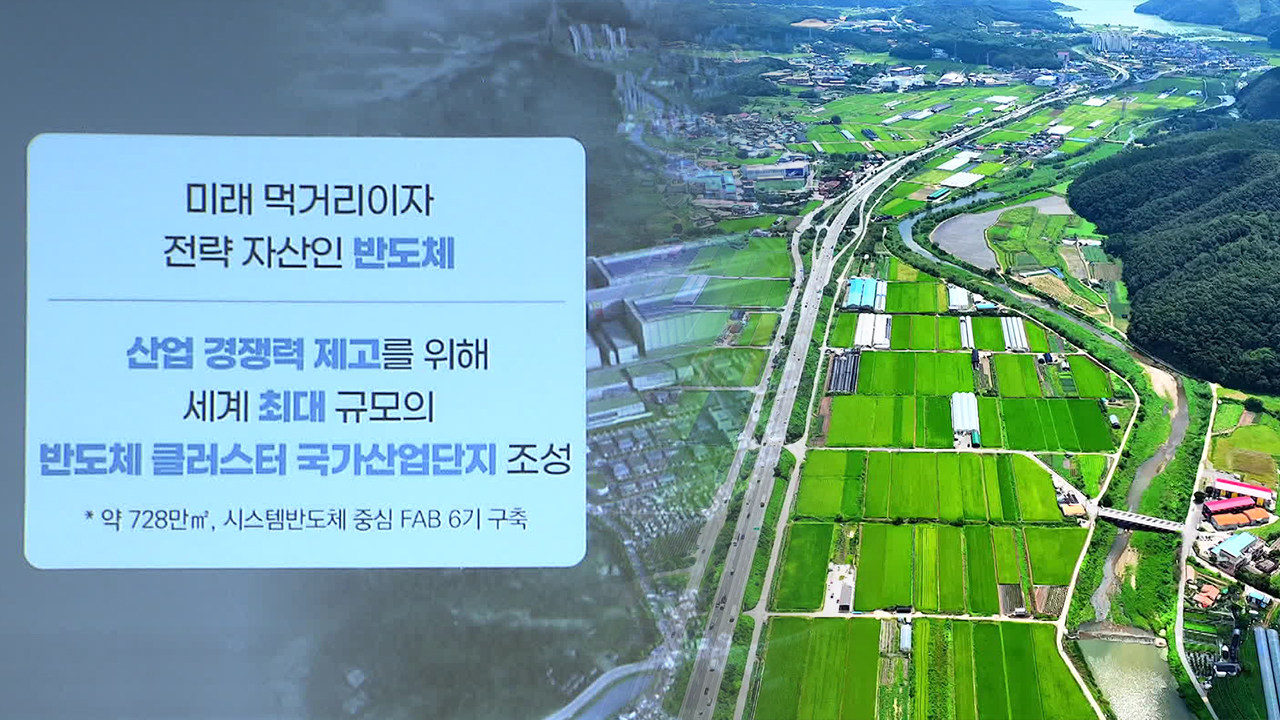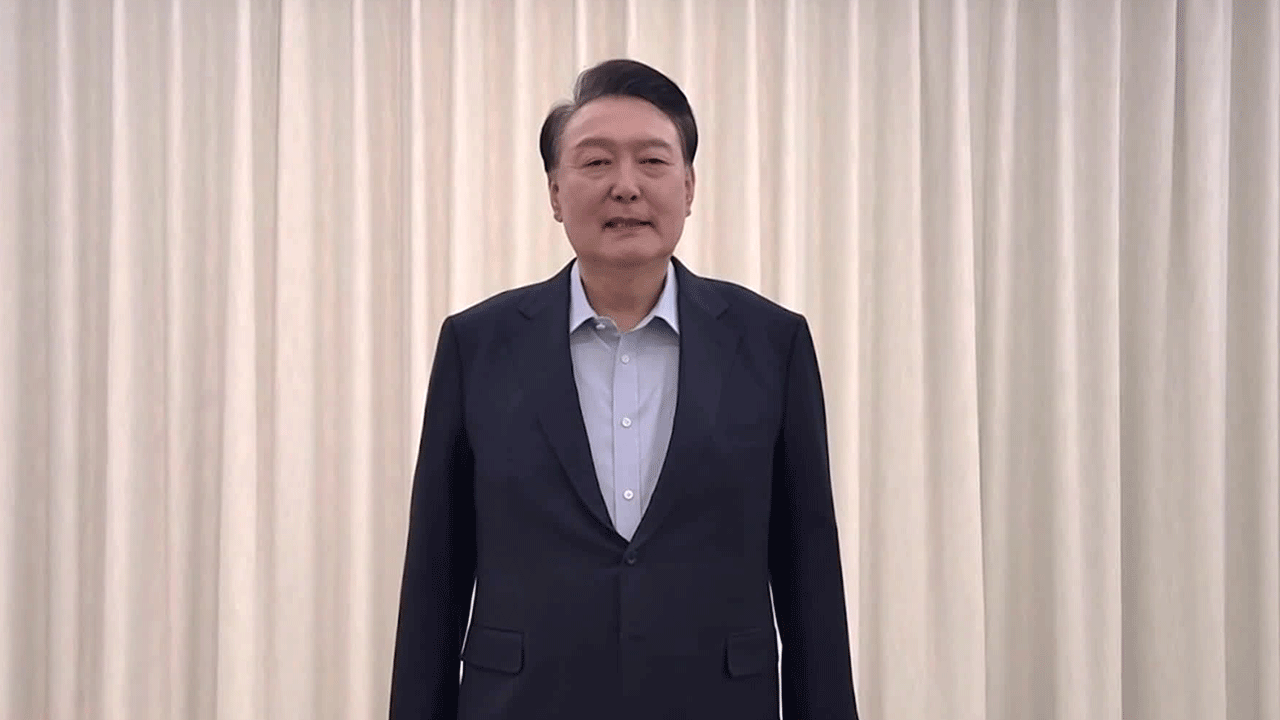Yongin semiconductor national industrial complex designated as key to K-semiconductor future
입력 2024.12.26 (23:56)
읽어주기 기능은 크롬기반의
브라우저에서만 사용하실 수 있습니다.
[Anchor]
The urgency to revitalize the domestic market has been heightened due to bleak export prospects.
In response, the government has announced plans to create the world's largest semiconductor-specialized city in Yongin, Gyeonggi Province, to enhance export competitiveness.
Will this be effective? Our reporter Hwang Da-ye has investigated.
[Report]
A 7.2 million square meter site in Yongin, Gyeonggi Province.
Currently, it is an empty field, but starting from the end of 2026, a semiconductor national industrial complex covering the area of 1,000 soccer fields will begin to take shape.
The plan is to gather six large-scale semiconductor manufacturing plants from Samsung Electronics, three power plants, and 60 partner companies to boost competitiveness.
The government has also halved the time from announcement to construction start.
[Park Sang-woo/Minister of Land, Infrastructure and Transport: "Time is a subsidy. There are various methods, but quickly establishing the industrial complex is..."]
This decision reflects the urgent need to revive the struggling Korean semiconductor industry.
Samsung Electronics, which has focused on general-purpose DRAM semiconductors, has been unable to respond quickly to the market shifting towards high-performance memory semiconductors for AI, resulting in a plummeting stock price that has yet to recover.
In the meantime, Samsung has been nearly caught up by Chinese companies in the DRAM market, and in the foundry market - the semiconductor outsourcing manufacturing business - its market share has halved in three years, widening the gap with TSMC.
As countries around the world inject massive subsidies into their domestic companies to protect semiconductor sovereignty, our response has been sluggish.
[Kim Yong-kwan/President of Samsung Electronics DS Management Strategy: "(Countries around the world) are putting their lives on the line to foster their domestic semiconductor industries and internalize supply chains. As a result, the status of our country's semiconductor industry is significantly threatened."]
In the National Assembly, a special law on semiconductors containing the basis for government subsidy support has been proposed.
However, discussions have stalled over exceptions to the 52-hour workweek for semiconductor research and development personnel, effectively derailing any progress by the end of the year.
This is Hwang Da-ye from KBS News.
The urgency to revitalize the domestic market has been heightened due to bleak export prospects.
In response, the government has announced plans to create the world's largest semiconductor-specialized city in Yongin, Gyeonggi Province, to enhance export competitiveness.
Will this be effective? Our reporter Hwang Da-ye has investigated.
[Report]
A 7.2 million square meter site in Yongin, Gyeonggi Province.
Currently, it is an empty field, but starting from the end of 2026, a semiconductor national industrial complex covering the area of 1,000 soccer fields will begin to take shape.
The plan is to gather six large-scale semiconductor manufacturing plants from Samsung Electronics, three power plants, and 60 partner companies to boost competitiveness.
The government has also halved the time from announcement to construction start.
[Park Sang-woo/Minister of Land, Infrastructure and Transport: "Time is a subsidy. There are various methods, but quickly establishing the industrial complex is..."]
This decision reflects the urgent need to revive the struggling Korean semiconductor industry.
Samsung Electronics, which has focused on general-purpose DRAM semiconductors, has been unable to respond quickly to the market shifting towards high-performance memory semiconductors for AI, resulting in a plummeting stock price that has yet to recover.
In the meantime, Samsung has been nearly caught up by Chinese companies in the DRAM market, and in the foundry market - the semiconductor outsourcing manufacturing business - its market share has halved in three years, widening the gap with TSMC.
As countries around the world inject massive subsidies into their domestic companies to protect semiconductor sovereignty, our response has been sluggish.
[Kim Yong-kwan/President of Samsung Electronics DS Management Strategy: "(Countries around the world) are putting their lives on the line to foster their domestic semiconductor industries and internalize supply chains. As a result, the status of our country's semiconductor industry is significantly threatened."]
In the National Assembly, a special law on semiconductors containing the basis for government subsidy support has been proposed.
However, discussions have stalled over exceptions to the 52-hour workweek for semiconductor research and development personnel, effectively derailing any progress by the end of the year.
This is Hwang Da-ye from KBS News.
■ 제보하기
▷ 카카오톡 : 'KBS제보' 검색, 채널 추가
▷ 전화 : 02-781-1234, 4444
▷ 이메일 : kbs1234@kbs.co.kr
▷ 유튜브, 네이버, 카카오에서도 KBS뉴스를 구독해주세요!
- Yongin semiconductor national industrial complex designated as key to K-semiconductor future
-
- 입력 2024-12-26 23:56:20

[Anchor]
The urgency to revitalize the domestic market has been heightened due to bleak export prospects.
In response, the government has announced plans to create the world's largest semiconductor-specialized city in Yongin, Gyeonggi Province, to enhance export competitiveness.
Will this be effective? Our reporter Hwang Da-ye has investigated.
[Report]
A 7.2 million square meter site in Yongin, Gyeonggi Province.
Currently, it is an empty field, but starting from the end of 2026, a semiconductor national industrial complex covering the area of 1,000 soccer fields will begin to take shape.
The plan is to gather six large-scale semiconductor manufacturing plants from Samsung Electronics, three power plants, and 60 partner companies to boost competitiveness.
The government has also halved the time from announcement to construction start.
[Park Sang-woo/Minister of Land, Infrastructure and Transport: "Time is a subsidy. There are various methods, but quickly establishing the industrial complex is..."]
This decision reflects the urgent need to revive the struggling Korean semiconductor industry.
Samsung Electronics, which has focused on general-purpose DRAM semiconductors, has been unable to respond quickly to the market shifting towards high-performance memory semiconductors for AI, resulting in a plummeting stock price that has yet to recover.
In the meantime, Samsung has been nearly caught up by Chinese companies in the DRAM market, and in the foundry market - the semiconductor outsourcing manufacturing business - its market share has halved in three years, widening the gap with TSMC.
As countries around the world inject massive subsidies into their domestic companies to protect semiconductor sovereignty, our response has been sluggish.
[Kim Yong-kwan/President of Samsung Electronics DS Management Strategy: "(Countries around the world) are putting their lives on the line to foster their domestic semiconductor industries and internalize supply chains. As a result, the status of our country's semiconductor industry is significantly threatened."]
In the National Assembly, a special law on semiconductors containing the basis for government subsidy support has been proposed.
However, discussions have stalled over exceptions to the 52-hour workweek for semiconductor research and development personnel, effectively derailing any progress by the end of the year.
This is Hwang Da-ye from KBS News.
The urgency to revitalize the domestic market has been heightened due to bleak export prospects.
In response, the government has announced plans to create the world's largest semiconductor-specialized city in Yongin, Gyeonggi Province, to enhance export competitiveness.
Will this be effective? Our reporter Hwang Da-ye has investigated.
[Report]
A 7.2 million square meter site in Yongin, Gyeonggi Province.
Currently, it is an empty field, but starting from the end of 2026, a semiconductor national industrial complex covering the area of 1,000 soccer fields will begin to take shape.
The plan is to gather six large-scale semiconductor manufacturing plants from Samsung Electronics, three power plants, and 60 partner companies to boost competitiveness.
The government has also halved the time from announcement to construction start.
[Park Sang-woo/Minister of Land, Infrastructure and Transport: "Time is a subsidy. There are various methods, but quickly establishing the industrial complex is..."]
This decision reflects the urgent need to revive the struggling Korean semiconductor industry.
Samsung Electronics, which has focused on general-purpose DRAM semiconductors, has been unable to respond quickly to the market shifting towards high-performance memory semiconductors for AI, resulting in a plummeting stock price that has yet to recover.
In the meantime, Samsung has been nearly caught up by Chinese companies in the DRAM market, and in the foundry market - the semiconductor outsourcing manufacturing business - its market share has halved in three years, widening the gap with TSMC.
As countries around the world inject massive subsidies into their domestic companies to protect semiconductor sovereignty, our response has been sluggish.
[Kim Yong-kwan/President of Samsung Electronics DS Management Strategy: "(Countries around the world) are putting their lives on the line to foster their domestic semiconductor industries and internalize supply chains. As a result, the status of our country's semiconductor industry is significantly threatened."]
In the National Assembly, a special law on semiconductors containing the basis for government subsidy support has been proposed.
However, discussions have stalled over exceptions to the 52-hour workweek for semiconductor research and development personnel, effectively derailing any progress by the end of the year.
This is Hwang Da-ye from KBS News.
-
-

황다예 기자 allyes@kbs.co.kr
황다예 기자의 기사 모음
-
이 기사가 좋으셨다면
-
좋아요
0
-
응원해요
0
-
후속 원해요
0















이 기사에 대한 의견을 남겨주세요.